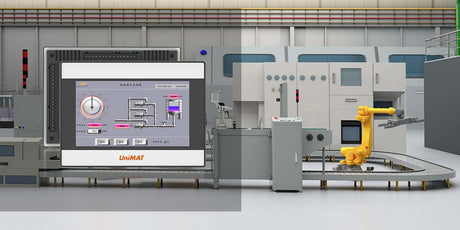1.Industry background
Since the first robot was manufactured in the United States in 1958,industrial robots have begun to develop.After decades of development,industrial robots have become indispensable high-tech automated production equipment in the industry.The characteristic of industrial robots is that they can be controlled by programming to complete the required actions and expected tasks.Although the robot is not as flexible as a human hand at this stage,it has some characteristics that humans do not have:it can replace the heavy labor of humans to realize the mechanization and automation of production,can work in harmful environments,avoid direct contact between the human body and the adverse environment,and protect human health.

2.Model selection
The equipment includes three manipulators,one beer machine,two material tables and one waste removal table.The beer machine also has a paper pusher shaft,which requires a total of 7 shafts,so two UN286s were selected for the customer.
The customer considered safety and wanted to prevent sudden power failure or failure,so the servo could not stop rushing out of the guide rail or falling,so a servo with a brake was selected.
3.Equipment
The following picture shows the customer's equipment.The equipment includes:paper feed table,paper feed shaft,material cleaning shaft,paper collection shaft,paper collection table,conveyor belt and beer machine.The beer machine is controlled by a frequency converter,which controls the brake pad,delays the detection and stops the machine,and controls the servo to push the paper to a fixed position before working.The paper feed table and paper collection table are controlled by ordinary motors,which can control the forward and reverse rotation.

4.Working process
Because two 286s are in the same control cabinet and the IO point margin is sufficient,the communication method adopts IO interaction(CPU1 receives the arrival signal sent by CPU2 and sends the next action signal).
The specific work process is:
1)All axes return to the origin.Because the three axes are on the same guide rail,in order to avoid collision between the manipulators when returning to the origin,a step-by-step return method is adopted.First,all Y axes return to the origin.After the Y axis returns to the origin,the X axis returns to the origin.Manually adjust the paper collection table and the paper feeding table to the appropriate position.
2)Paper removal.When starting,the paper feeding table detection switch(opposite photoelectric switch)detects whether there is paper.If there is no paper,the paper feeding table rises and stops when it detects that there is paper.The three axes reach the initial position,the paper feed axis cylinder moves,the paper feed table blows the paper(blows out gaps between the papers to avoid not sucking up the paper or sucking up too much paper),the paper feed axis,the cleaning axis and the paper collection axis simultaneously descend to pick up the paper,inhale,and after a period of inhalation,all axes begin to rise,and when they reach the highest position for picking up the paper,the paper feed axis stops blowing the paper and the paper feed axis cylinder is reset,the conveyor starts,and the paper picking is completed.
3)Paper placement.After the paper picking is completed,all axes move to the left and reach the paper placement position,the cleaning axis cylinder moves,and the paper is placed.Before reaching the lowest position for placing the paper,the conveyor stops moving,and when it reaches the lowest position,all axes blow air and put the paper down.All axes return to the uppermost position,all axes return to the initial position,the beer machine pushes the paper into place,the clutch is released,and the delayed detection stops.The paper picking action can be performed only after the beer machine is completed.

5.Unimat Robotic Solutions:
| Module Type | Order No. | Quantity |
|---|---|---|
| CPU286L | UN286-2AM20-0XB0 | 2 |
| EM123-16DI/16DO | UN123-1BL22-0XA0 | 2 |
| HMI-UH310E | UH310-2EU01-0AA0 | 1 |
| 0.2KW Servo | UM060-00R2F-30BA | 1 |
| 2.3KW Servo | UM130-02R3F-15HA | 6 |
| 200W Servo Drive | US112-00R8 | 1 |
| 2.3KW Servo Drive | US132-02R0 | 6 |
6.Summary
Combined with the customer's production process,we used Unimat's self-developed motion control PLC,UN286.UN286 inherits the characteristics of traditional PLC and has its own motion control library,making the motion more precise.Customers can change the motion parameters on the touch screen and return to the origin with one click,which is convenient and simple.









